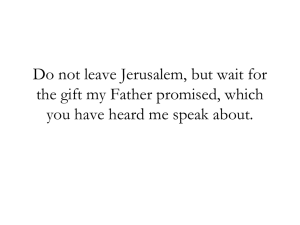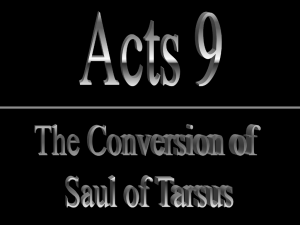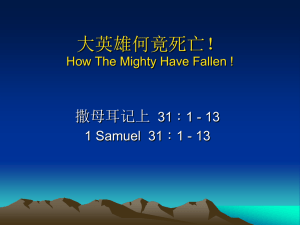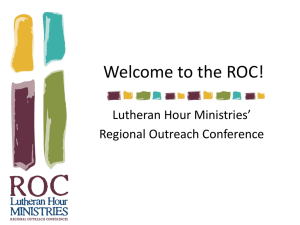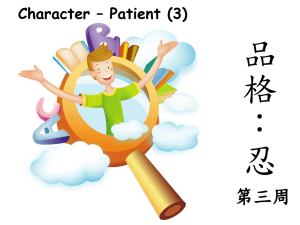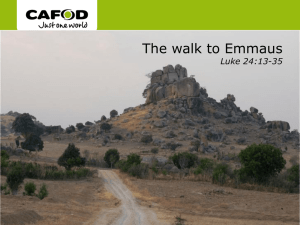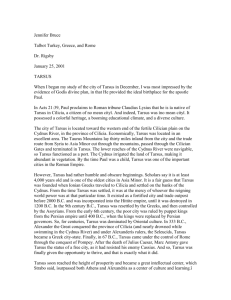Paul`s Life - Living Theology
advertisement
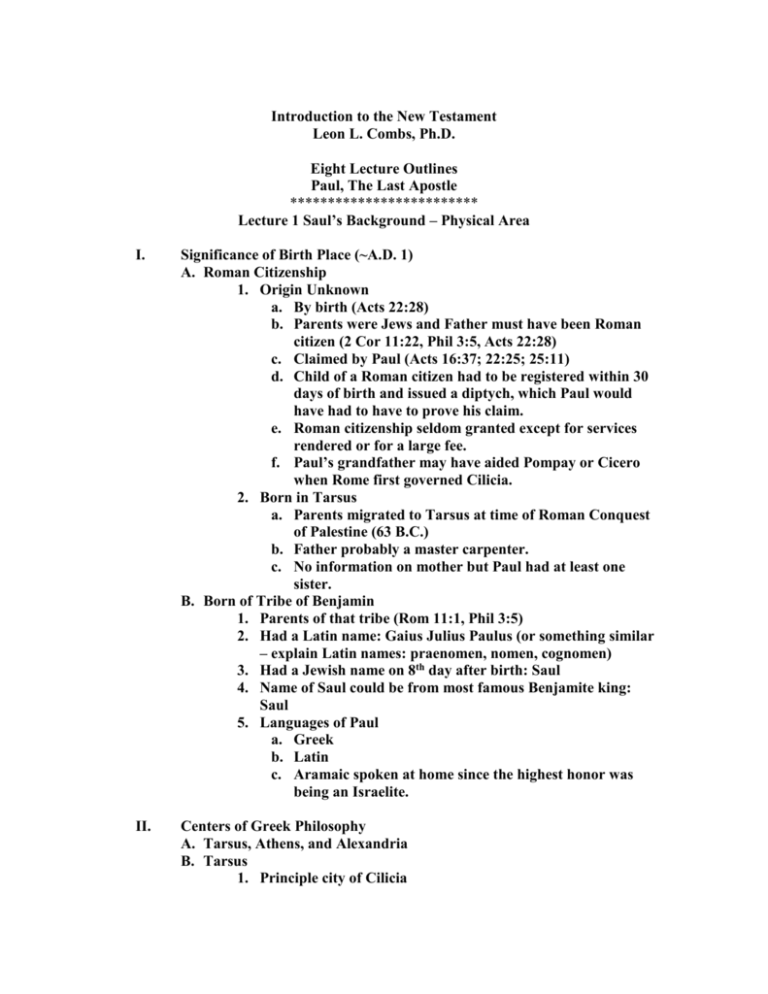
Introduction to the New Testament Leon L. Combs, Ph.D. Eight Lecture Outlines Paul, The Last Apostle ************************* Lecture 1 Saul’s Background – Physical Area I. Significance of Birth Place (~A.D. 1) A. Roman Citizenship 1. Origin Unknown a. By birth (Acts 22:28) b. Parents were Jews and Father must have been Roman citizen (2 Cor 11:22, Phil 3:5, Acts 22:28) c. Claimed by Paul (Acts 16:37; 22:25; 25:11) d. Child of a Roman citizen had to be registered within 30 days of birth and issued a diptych, which Paul would have had to have to prove his claim. e. Roman citizenship seldom granted except for services rendered or for a large fee. f. Paul’s grandfather may have aided Pompay or Cicero when Rome first governed Cilicia. 2. Born in Tarsus a. Parents migrated to Tarsus at time of Roman Conquest of Palestine (63 B.C.) b. Father probably a master carpenter. c. No information on mother but Paul had at least one sister. B. Born of Tribe of Benjamin 1. Parents of that tribe (Rom 11:1, Phil 3:5) 2. Had a Latin name: Gaius Julius Paulus (or something similar – explain Latin names: praenomen, nomen, cognomen) 3. Had a Jewish name on 8th day after birth: Saul 4. Name of Saul could be from most famous Benjamite king: Saul 5. Languages of Paul a. Greek b. Latin c. Aramaic spoken at home since the highest honor was being an Israelite. II. Centers of Greek Philosophy A. Tarsus, Athens, and Alexandria B. Tarsus 1. Principle city of Cilicia 2. Part of Roman Empire in 64 B.C. 3. No mean city (Acts 21:39) 4. University city: schools devoted to philosophy, rhetoric, and general education. Some of its philosophers had a wide reputation. ************************* Lecture 2 Saul’s Background – Education I. Place A. Jerusalem 1. Why not Tarsus for education? 2. Tarsus universities taught pagan moral philosophy 3. Sent to Jerusalem at probably A.D. 14 when Augustus died B. Studied for five-six years under Gamaliel 1. Grandson of Hillel 2. Paul said that he advanced beyond many of his age (Gal 1:14) 3. Mastered the corpus of the law and observed it in detail 4. Paul learned diatribe method of debate 5. Paul learned to dissect a text into scores of possible meanings. 6. Paul became part lawyer and part preacher 7. Lawyer aspect needed to persecute those who broke the law II. Tent Making A. Rabbis took no pay so all had to have a trade B. Probably left Jerusalem in his early 20’s C. Went to Tarsus probably to participate in family tent making profession III. Return to Jerusalem A. Probably about 30 years old B. Probably married 1. Jews rarely celibate 2. Parenthood a prerequisite for membership in Sanhedrin ************************* Lecture 3 Saul Paul I. Saul the Pharisee A. Education and training led to seat on Sanhedrin in Hall of Polished Stones B. Black beard, blue-fringed robe, and the amulet strapped to a turbanlike headdress all portrayed a proud Pharisee. II. III. IV. V. C. Kept all fasts, daily prayers in proper order, busy preparing himself for heaven. D. He was respected, but feared. Saul the Persecutor of the Church A. Followers of Jesus had developed into a growing number of groups. B. To say that Jesus was the Messiah was blasphemy to Saul, so he devoted himself to the eradication of these groups. C. Every suspect had to stand before the elders while Paul asked them to curse Jesus 1. Each had the right to be heard 2. Some stated that they had seen Jesus die and saw Him later 3. Some said that Jesus had healed them 4. Some sent to dungeons 5. Some flogged (“forty stripes save one”) 6. Some cursed Jesus; many did not Encounter with Stephen A. Paul encountered Stephen with the time-honored public debate B. Stephen won with congregational approval C. Temple guards arrested Stephen and arraigned him before the Sanhedrin with Paul in the background (Acts chapter 6 and 7) 1. Stephen argued from Moses forward 2. Stephen said that they had murdered the Messiah 3. The members of the Sanhedrin raged and Stephen remained calm 4. The end was a Stephen stoned to death without Paul throwing a stone, but with approval Encounter with Jesus A. After the death of Stephen the Jews began a systematic suppression of the new religion with Paul as the chief agent B. But the religion flourished C. Paul asked for official papers to eliminate “The Way” D. With Jewish authority, Paul headed toward Damascus (discuss why that area) E. But on the way, God had other plans (Acts chapter 9) 1. A bright light surrounded Paul as he neared Damascus 2. He heard a voice “Saul, Saul, why do you persecute Me?” 3. He inquired and the voice said, “I was Jesus, whom you are persecuting.” 4. Paul was blind and had to be led to Damascus 5. There Paul waited without food or drink New Mission Defined A. The Lord told Ananias to instruct Saul as to his new mission in life B. Ananias told Saul what the Lord had said and that Saul was to be filled with the Holy Spirit (Acts 9:17-19) C. Saul then began to proclaim Jesus as the Son of God! (Acts 9:20-31) D. Saul now brilliantly proclaimed that “The Way” was indeed correct and that the Messiah had come. E. Saul changed from prosecuting attorney to defense attorney 1. Name changed to Paul (little one) 2. Paul went to Arabia to be taught by Jesus (Gal 1:17-18) 3. Paul returned three years later to begin his new ministry ************************* Lecture 4 Paul, the Apostle I. II. III. Definitions A. An apostle of Jesus Christ had to have seen Jesus on earth and was anointed by Him for service as a missionary to the world (Acts 1:1526). B. Saul then was the last apostle Defense A. Saul had to defend his apostleship on several occasions (1 Cor 9:1-2; 15:9, 2 Cor 1:1, 1 Tim 2:7, 2 Tim 1:1; 1:11) B. After fourteen years, Paul met with “those of high reputation” to defend his apostleship. Elaborate! C. James, Cephas, and John all gave the right hand of fellowship and only asked him to remember the poor (Gal 2: 1-10) Paul then began his missionary trips throughout the known world A. Commissioned to the Gentiles (Eph 3:1, Acts 13:46). (Discuss roles of Peter to the Jews and Paul to the Gentiles concerning background.) B. Important companion, Barnabas (Son of Encouragement) 1. Barnabas an uncle or cousin of John Mark 2. Paul and Barnabas went to Jerusalem for discussions on the role of circumcision (Acts 15:1-12) ************************* Lecture 5 Paul, Apostle Trips I I. First Trip (probably A.D. 47-48) A. With Barnabas and John Mark to Cyprus (native place of Barnabas) B. Salamis was first stop on Cyprus, followed by Paphos 1. Paphos on other end of island of Cyprus 2. Paul rebuked a false prophet 3. Proconsul became a believer C. From Paphos to Perga in Pamphylia where John Mark left them D. To Antioch in Pisidia E. To Iconium 1. Lystra (performed miraculous cure of a cripple) 2. Derbe (many disciples joined them, Acts 14:7-21) F. Revisited Lystra, Iconium, and Antioch encouraging and ordaining elders G. Then to Attalia H. Then to Antioch in Syria I. So ends the first missionary journey (Acts 14:21-27) II. Council at Jerusalem (Acts 15 and Gal 2) A. Role of circumcision in Christianity had been introduced B. Paul and Barnabas argued against any such traditions being added to Christianity (discuss “sola scriptura”) C. The council formally dismissed any such traditions as not being Christian ************************* Lecture 6 Paul, Apostle Trips II I. Second Trip General A. Barnabas wanted to take John Mark and Paul did not B. Disagreement split the team of Paul and Barnabas C. Paul chose Silas for his companion on this trip II. Second Trip Specifics A. First to Syria Cilicia visiting churches B. Then to Derbe and Lystra where they found Timothy 1. Paul circumcised Timothy 2. Why did Paul circumcise Timothy? C. By Mysia to Troas 1. Avoided Asia and Bithynia due to the Holy Spirit’s direction 2. Paul had a vision of a man in Macedonia asking for help 3. Luke seems to have joined them here D. Then to Neapolis and to Philippi 1. First convert at Philippi was Lydia who was already a Godworshiper 2. Stayed at Lydia’s home for some time. 3. Female slave harassed them and Paul cast out (in the name of Jesus Christ) an evil spirit 4. Slave owners drug Paul and Silas to the magistrates 5. They were beaten and put in prison 6. A God-sent earthquake freed them 7. Jailor was terrified and then born again, as well as his family E. Then on to Thessalonica 1. Paul preached Jesus in a Jewish synagogue and many were born again. 2. Paul and Silas were then forced out and probably stayed with Jason for some time. F. Then to Berea 1. Many Jews and Gentiles were converted 2. Riot led to Paul’s departure with Silas and Timothy left G. Then to Athens 1. Paul left alone in August A.D. 51 (1 Thes 3:1) 2. Paul gave famous discourse (Acts 17:22-31) H. Then to Corinth 1. Worked as a tent-maker 2. Stayed with Aquila and Priscilla 3. Silas and Timothy joined him and all stayed about 1.5 years I. Then into Syria 1. Took Aquila and Priscilla to Ephesus 2. Paul then continued to Jerusalem ************************* Lecture 7 Paul, the Physical End I. Third Trip General A. Stayed quite awhile at Antioch B. Then over all the country of Galatia and Phrygia C. He was strengthening disciples (Acts 18:23) and giving directions for collections for the saints in Jerusalem (1 Cor 6:1-2) II. On to Ephesus (~October A.D. 53) A. Found ~12 disciples who had received instructions from Apollos. B. These disciples had only received the baptism of John C. Paul explained the ministry of the Holy Spirit and baptized them (discuss this and emphasize that it is not an example of a “second blessing” D. Many believed in his two-year teaching and many exorcists burned their books. E. Then traveled to Corinth and came back to Ephesus 1. Wrote 1 Cor 2. People who made moneymaking idols were losing money so they revolted against Paul and he left. On to Troas where he preached with success but lamented not have Titus with him On to Macedonia and Philippi A. Met with Titus and probably Timothy B. Titus sent to Corinth with Paul’s second letter and to finish collection (Acts 8:6; 16-18) C. Paul wrote to Galatia mainly because of the teachers putting Jewish legalism into the Christian teaching. On through Macedonia to Corinth A. Stayed about three months (Acts 20:2-3) B. Wrote Romans about A.D. 57 III. IV. V. VI. To Jerusalem with Luke A. At Troas restored Eutychus to life (Acts 20:2-38) B. Traveled by land to Assos C. Traveled by ship to Miletus (met by Ephesus elders) D. Then to Tyre where he stayed for about seven days E. Sailed to Ptolemais to Caesarea F. Despite warnings of Philip traveled (probably by horse) to Jerusalem VII. In Jerusalem A. This was his 5th visit to Jerusalem since his conversion B. He related to James and the elders what God had done C. Jews from Asia stirred people up against Paul and dragged him out of the Temple and were about to kill him. D. Soldiers/Centurions stopped the blows and ordered Paul to be chained and taken to the barrack E. Paul tried to defend himself (Acts 21:40; 22:1-21) but the people were enraged and the commander ordered Paul back to the barracks to be scourged. F. Paul declared his Roman citizenship to halt the punishment VIII. Paul’s defenses A. Before Felix (governor of Judea Acts 22:21-23:24) 1. Felix trembled under Paul’s preaching 2. Paul kept a prisoner for two years IX. X. XI. XII. B. Before Festus (new governor) 1. Defense unsuccessful 2. Paul appealed unto Caesar so he had to be taken to Rome (Acts 25:1-3) C. Before Agrippa (king) 1. King said he almost was converted 2. Found nothing wrong with Paul 3. Paul had already appealed to Caesar so he had to be sent to Rome D. To Rome 1. Stayed in his own rented house under care of a soldier 2. Permitted to preach for about 2 years (~spring A.D. 62) 3. Trial before Nero ended in his acquittal and liberation Traveled to Macedonia then to Ephesus then to Colossae and Leodicea Perhaps then traveled to Spain for 2 years and wrote 1 Tim Traveled to Crete (wrote Titus) then to Nicopolis where he was arrested and sent to Rome Second trial in Rome A. Chained and treated as a criminal (2 Tim 2:9) B. Many friends left him perhaps like Demas (2 Tim 4:10) loved the world before the Gospel C. Only Luke stayed with Paul (2 Tim 4:11) D. Paul died by decapitation (Clement Rom. 1.5) ************************* Lecture 8 Paul Continues Through Time I. Why He Wrote What He Wrote A. Urgency of Short Time Here and Judgment 1. 2Cor 5:10 2. 2 Cor 5:11 B. Not Wanting Discipline from the Lord (Heb 6:12-13) C. Teach Christians to Defend Their Faith (1 Peter 3:15) D. To Disciple the Born-Again (Matt 28: 18-20) E. Teach Christians how to Conform to the Image of Christ (Rom 12:2) F. He Had to Do So (1 Cor 9:16) G. He was so aware of what God had done for him (Rom 1:14) II. Writings Preserved Unto Now A. Romans B. First Corinthians C. Second Corinthians D. Galatians E. Ephesians F. Philippians G. Colossians H. First Thessalonians I. Second Thessalonians J. First Timothy K. Second Timothy L. Titus M. Philemon III. Influence Through the Ages A. Immeasurable except by God B. Some vastly important influences we know about (discuss each) 1. Augustine 2. Martin Luther – The Reformation 3. John Wesley 4. Me 5. You References 2. Gunther Bornkamm, “Paul”, Hodder and Stoughton, 1969 3. John Pollock, “The Apostle, A Life of Paul”, Chariot Victor Publishing, 1985. 4. C. H. Dodd, “The Meaning of Paul for Today”, New American Library, 1974. 5. J. D. Douglas, General Editor, “Encyclopedia of Religious Knowledge”, Baker Book House, 1991, pp 636-641. 6. “The Revell Bible Dictionary”, Fleming H. Revell Company, 1990. 7. Eusebilus (A.D. 263-339) translated by G. A. Williamson, “The History of the Church from Christ to Constantine”, Dorset Press, NY, 1965. 8. Kenneth Scott Latourette, Editor, “A History of Christianity”, Volumes I, Beginnings to 1500, Prince Press, 1997. 9. A. M. Renwick, “The Story of the Church”, Inter-Varsity Press, 1958. 10. F. F. Bruce, “New Testament History”, Doubleday & Company, Inc., Garden City, NY, 1971. 11. Geoffrey W. Bromiley, General Editor, “The International Standard Bible Encyclopedia”, William B. Eerdmans Publishing Company, Grand Rapids, Michigan, 1986. 12. Merrill F. Unger, “The New Unger’s Bible Dictionary”, Moody Press, 1988. Photographs 1. 2. 3. 4. 5. 6. 7. 8. 9. 10. 11. 12. 13. 14. 15. 16. 17. 18. 19. 20. Athens Alexandra Rome Tarsus Slide of samples of Paul’s languages Map of typical tentmaking Slide of important philosophers affecting Paul Pharisee typical dress including prayer shawl Map of area in which he persecuted Christians Slide of a stoning of a Christian Slide of encounter with Jesus as most often depicted Map of trip one Map of trip two Map of trip three Slide of possible defense by Paul before kings Slide of a typical beheading Slide of heaven opening to receive Paul Slide of many people reading Paul’s writings Slides of some church buildings through the ages Slide of a modern church building with thousands of Christians hearing the words of God through Paul read and preached
